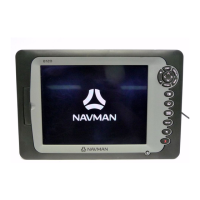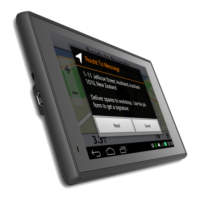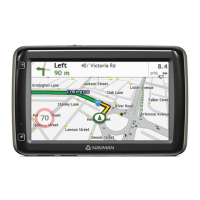Do you have a question about the Navman Tracker 5380 and is the answer not in the manual?
Explains manual power control and how auto power functions, including when the unit turns on/off with the boat's ignition.
Explains how to activate the MOB feature to save the boat's position and navigate back to it.
Introduces the two main navigation methods: going straight to a point and following a route.
Explains how the chart and highway displays show navigation data for reaching a destination point.
Details methods for navigating to a waypoint, either from the chart display or the waypoints display.
Describes how to set a destination point on the chart and cancel navigation to it.
Explains how to prepare, start, navigate, skip, and cancel routes, which are lists of waypoints.
Details the components of a typical chart display, including data header, compass, scale, boat position, and chart symbols.
Explains how to plot a course, calculate leg lengths, total distance, and convert courses into routes.
Explains the highway display's bird's-eye view of the boat's course, showing CDI lines and boat position.
Covers the creation, editing, and moving of waypoints from both the chart and waypoints displays.
Refers to section 3-1-2 for instructions on navigating to a specific waypoint.
Covers the creation, editing, and deletion of routes, which link multiple waypoints for navigation.
Details step-by-step processes for creating new routes from both the chart and routes displays.
Refers to section 3-1-3 for instructions on navigating along a created route.
Details procedures for accurately recording fuel added or removed, especially for full or partial tank fills.
Describes the fuel display, showing used fuel, remaining fuel, flow rate, economy, speed, and range.
Provides step-by-step instructions for creating fuel consumption curves by recording engine RPM and speed data.
Guides on displaying and interpreting fuel consumption curves to compare boat performance and optimize economy.
Covers saving, loading, deleting files, reading information, formatting, and sorting user card data.
Provides a visual overview of all available setup option menus and their default settings.
Configures GPS source (Internal, NMEA, NavBus), DGPS source, static navigation, and speed/course filters.
Covers fuel setup including tank full, remaining, clear used, tank size, number of engines, calibration, and flow filter.
Manages track recording settings, including record display, plotting interval, memory usage, and track deletion.
Configures various audible and visual alarms for navigation events like arrival radius, anchor, XTE, danger, and fuel levels.
Provides guidance on selecting an optimal mounting location and describes flush and bracket mounting procedures.
Explains how to wire the power/data cable for basic or auto power, and connect external alarms.
Guides on selecting and installing GPS antennas, including internal, external, and compatible GPS/DGPS sources.
Guides through initial setup, language selection, data changes, and a test run to verify equipment functionality.
Addresses common issues like the TRACKER not turning on, not turning off, beeping without display, or showing the wrong language.
Covers troubleshooting GPS issues like no fix, inaccurate position, chart mismatch, visibility, time/date errors, autopilot, and DGPS fixes.
Addresses issues with inaccurate fuel readings, low fuel indication, single flow rate display, erratic readings, and no economy reading.
Explains manual power control and how auto power functions, including when the unit turns on/off with the boat's ignition.
Explains how to activate the MOB feature to save the boat's position and navigate back to it.
Introduces the two main navigation methods: going straight to a point and following a route.
Explains how the chart and highway displays show navigation data for reaching a destination point.
Details methods for navigating to a waypoint, either from the chart display or the waypoints display.
Describes how to set a destination point on the chart and cancel navigation to it.
Explains how to prepare, start, navigate, skip, and cancel routes, which are lists of waypoints.
Details the components of a typical chart display, including data header, compass, scale, boat position, and chart symbols.
Explains how to plot a course, calculate leg lengths, total distance, and convert courses into routes.
Explains the highway display's bird's-eye view of the boat's course, showing CDI lines and boat position.
Covers the creation, editing, and moving of waypoints from both the chart and waypoints displays.
Refers to section 3-1-2 for instructions on navigating to a specific waypoint.
Covers the creation, editing, and deletion of routes, which link multiple waypoints for navigation.
Details step-by-step processes for creating new routes from both the chart and routes displays.
Refers to section 3-1-3 for instructions on navigating along a created route.
Details procedures for accurately recording fuel added or removed, especially for full or partial tank fills.
Describes the fuel display, showing used fuel, remaining fuel, flow rate, economy, speed, and range.
Provides step-by-step instructions for creating fuel consumption curves by recording engine RPM and speed data.
Guides on displaying and interpreting fuel consumption curves to compare boat performance and optimize economy.
Covers saving, loading, deleting files, reading information, formatting, and sorting user card data.
Provides a visual overview of all available setup option menus and their default settings.
Configures GPS source (Internal, NMEA, NavBus), DGPS source, static navigation, and speed/course filters.
Covers fuel setup including tank full, remaining, clear used, tank size, number of engines, calibration, and flow filter.
Manages track recording settings, including record display, plotting interval, memory usage, and track deletion.
Configures various audible and visual alarms for navigation events like arrival radius, anchor, XTE, danger, and fuel levels.
Provides guidance on selecting an optimal mounting location and describes flush and bracket mounting procedures.
Explains how to wire the power/data cable for basic or auto power, and connect external alarms.
Guides on selecting and installing GPS antennas, including internal, external, and compatible GPS/DGPS sources.
Guides through initial setup, language selection, data changes, and a test run to verify equipment functionality.
Addresses common issues like the TRACKER not turning on, not turning off, beeping without display, or showing the wrong language.
Covers troubleshooting GPS issues like no fix, inaccurate position, chart mismatch, visibility, time/date errors, autopilot, and DGPS fixes.
Addresses issues with inaccurate fuel readings, low fuel indication, single flow rate display, erratic readings, and no economy reading.
| Display Resolution | 480 x 272 pixels |
|---|---|
| Waterproof | No |
| Touchscreen | Yes |
| Lane Guidance | Yes |
| Speed Camera Alerts | Yes |
| Bluetooth | Yes |
| Preloaded Maps | Yes |





